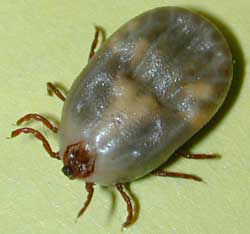Spring has sprung and that means that the ticks are not far behind. You  remember ticks: those nasty, blood-sucking arachnids that can feed on your horse for days. And while they’re feasting, they can cause irritation, allergic reactions and in some cases, transmit Lyme disease.
remember ticks: those nasty, blood-sucking arachnids that can feed on your horse for days. And while they’re feasting, they can cause irritation, allergic reactions and in some cases, transmit Lyme disease.
There are three types of ticks that you should be on the watch for on your horses:

Wood Ticks – these are black, typically with a silver pattern on its back, just behind the head. At their smallest, these wood ticks can be about the size of a key on your cell phone and when engorged on your horse’s blood, they can become the size of a small grape. Yuck!
![]()
Dog Ticks – these more more oblong in shape, about half the size of wood ticks and brown instead of black.
~~~
![]() Deer Ticks – these are the smallest ticks and in their larval and nymph stages of life, they are almost invisible to the naked eye! In fact, as you can see from the picture, the mature adult is about the size of a poppy seed. Deer ticks are the ones that transmit Lyme disease (wouldn’t you know it would be the tick that’s hardest to spot!)
Deer Ticks – these are the smallest ticks and in their larval and nymph stages of life, they are almost invisible to the naked eye! In fact, as you can see from the picture, the mature adult is about the size of a poppy seed. Deer ticks are the ones that transmit Lyme disease (wouldn’t you know it would be the tick that’s hardest to spot!)
To give you an advantage in being able to find them on your horse, you should know that:
- the deer tick prefers to feast along a horse’s tailbone and the crest of his mane
- ticks cause horses to rub in an effort to scratch where the tick is irritating their skin
- ticks will usually cause a welt at the attachment site, sometimes, the welt can be over an inch in diameter
Remember to always use tweezers when attempting to remove a tick and grab near its head. If you only grab the body and pull, the head could become dislodged from the tick’s body and stay attached to your horse’s skin.
You may have heard some wive’s tales about using baby oil or petroleum jelly to remove a tick. While this will in fact work (the lack of oxygen will cause the tick to leave the attachment site), the tick may also regurgitate blood back into your horse which increases the risk of your horse contracting Lyme’s disease.
Once you’ve removed the tick, kill it! The best method of ensuring its death is to place it in a jar of rubbing alcohol. Now, be sure to wash the attachment site with a mild antiseptic and then wash your hands.
Be One With Your Horse!
 out. As much as your horse needs some preconditioning before hitting the trails hard, your trailer needs some quick conditioning.
out. As much as your horse needs some preconditioning before hitting the trails hard, your trailer needs some quick conditioning.